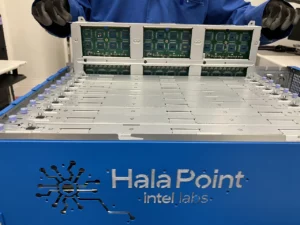Intel’s Hala Point represents a transformative leap in computing, offering a glimpse into the future where machines operate more like the human brain.
This revolutionary system combines memory storage and data processing into a unified function, mimicking the brain’s own mechanisms.

This breakthrough not only promises a new era of sustainable AI technology but also supports a novel learning approach.
Intel’s Neuromorphic Breakthrough
Intel’s collaboration with over 200 members of the Intel Neuromorphic Research Community—including government labs and academic institutions—plays a crucial role in refining Hala Point.
This collaboration focuses on sustainable and efficient AI deployment, deeply rooted in neuroscience principles.
However, despite these advancements, the field of neuromorphic computing, particularly in software development, remains in its early stages.
In essence, Hala Point does not merely advance hardware technology; it revolutionizes how AI systems are conceived and developed.
This system offers a promising pathway toward not just more efficient computing but also a deeper integration of AI into our digital and physical environments.
It could potentially transform the very landscape of artificial intelligence and its applications.

